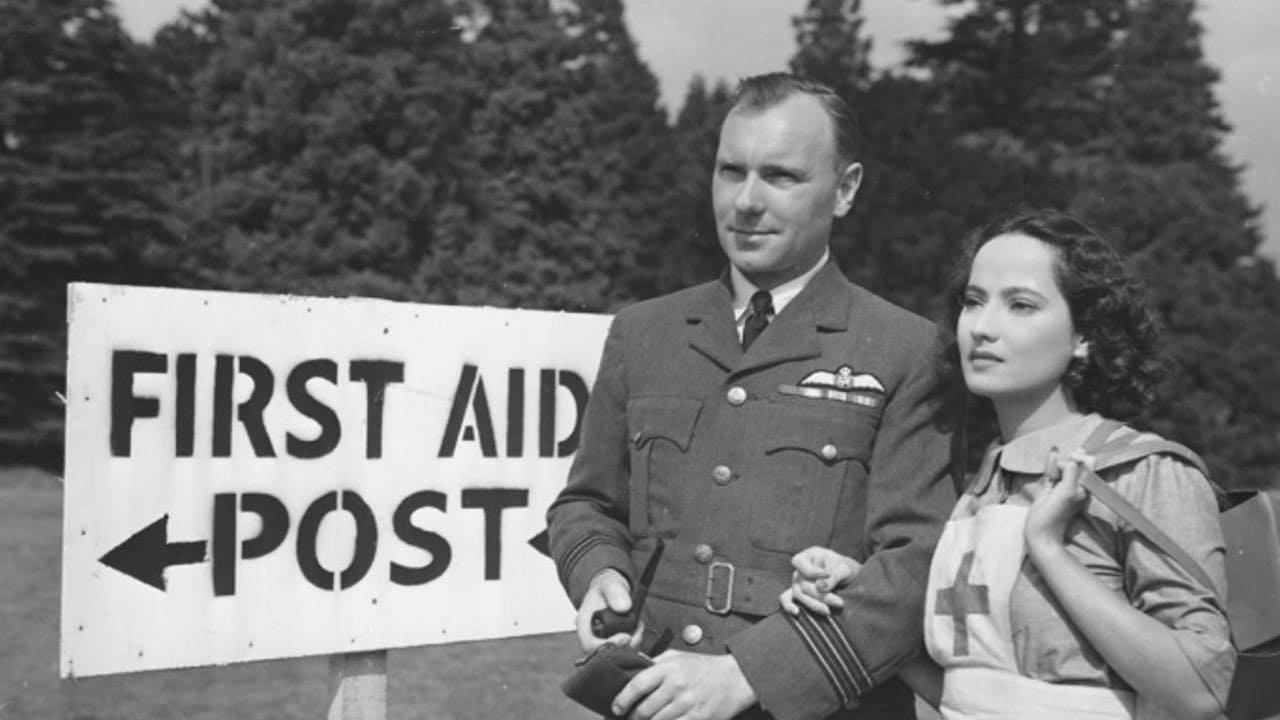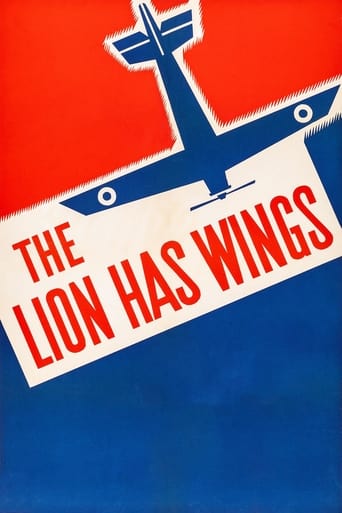

All of these films share one commonality, that being a kind of emotional center that humanizes a cast of monsters.
... View MoreA film of deceptively outspoken contemporary relevance, this is cinema at its most alert, alarming and alive.
... View MoreAll of these films share one commonality, that being a kind of emotional center that humanizes a cast of monsters.
... View MoreThere's a more than satisfactory amount of boom-boom in the movie's trim running time.
... View MoreI rate THE LION HAS WINGS (1939) a 7/10 on the strength of the fascinating documentary footage that makes up much of the first half of the film. (The scenes involving the actors are considerably less fascinating.)THE LION HAS WINGS is a British propaganda film that seeks to stir up support for the war effort by appealing to a sense of British pride, with particular focus on Britain's air supremacy in its war with Germany.The early portion of the film uses documentary footage to paint a picture of idyllic British life, in sharp contrast to the military state being run by Adolf Hitler. Hitler, surrounded by a sea of guards, is contrasted with Great Britain's King George VI, who walks openly among his people. The film succeeds in demonizing Hitler as an unscrupulous leader with an outdated hunger for conquest. The film even makes use of archival footage of one of Hitler's early speeches as it drives home the point that he's broken lots of promises by annexing neighboring lands. Excerpts are highlighted from "Mein Kampf" outlining the true ambitions of a man who does not want peace (at least until Germany rules Europe).The movie is very interesting from a historical standpoint. It covers recent events in world history and also offers a look at British society in the 1930s, touching upon things like sports and recreation, hospital care, and housing improvements. There's footage from an air show, demonstrating the talents of British flyers, as well as some really cool looks at airplane and ammunition manufacture and the "balloon barrage" defense against air strikes. In addition to the archival footage of Hitler and King George VI, we get to hear British Prime Minister Neville Chamberlain's radio address informing the British people that war is declared. With the narrator guiding you along, the movie is quite educational.The actors take over around the halfway point and the film becomes more of a dramatization of bombing raids abroad and the RAF's defense of the homeland. This may have been just the thing to arouse patriotism at the time, but it's rather hum-drum now. These dangerous and exciting missions have been brought to life much better in other films.The main players are Ralph Richardson and the always lovely Merle Oberon, as a young couple who answer the call when their country needs them. What story is there is no great shakes, but it serves its purpose within the film. There are others in the cast, though most of the parts are minor. Flora Robson has a cameo as Queen Elizabeth I in a scene about England's defense against the Spanish Armada (a scene borrowed from the 1937 film FIRE OVER ENGLAND).THE LION HAS WINGS ties England's proud naval heritage with Britain's more recent mastery of flight, comparing the ace pilots of the RAF with Sir Francis Drake and the other great English seamen. And the film makes it very clear that Great Britain had no choice but to go to war with Hitler's Germany, after repeated offenses on the continent and no effort to discuss a peaceful settlement. As the narrator puts it, the British people prefer to win sports matches, but they can win wars, too, if they must. It's also stressed that the highly skilled airmen of the RAF bomb only strategic military targets, not cities full of innocent civilians (another dig at the evil dictator).Released at a time when Great Britain had just entered what would become World War II, THE LION HAS WINGS makes sure the British people know what they're fighting for and appeals to their nationalistic pride to win support for what may have been, at the time, an unpopular war.
... View MoreReleased in 1939 as Britain was engaging Hitler's war machine, this B&W film cannot property be called a documentary. It is a dramatized propaganda film that masquerades as a fact-based call to arms.The film portrays Britain as an idyllic land of goodwill and happy citizens. In contrast, Germany is portrayed by shots of Nazi soldiers spurred into action by Hitler's hateful histrionics. This is not a film of unbiased observation, obviously. It is the kind of cinema that inflames the emotions and plays on the heartstrings with stirring speeches of patriotism and images of ruddy-cheeked children and self-sacrificing lovers.Be sure to read the "Goofs" section for this film as the film does contain inaccuracies. Accuracy was not the primary concern of its makers. They wished to motivate British viewers while assuring them that Britain is prepared, just, and in the right. I wonder if viewing the film was considered a patriotic duty at the time?This film is well worth seeing for its historic footage and as an artifact of its time. Note that--like almost all who go to war--they underestimate the duration of impending hostilities. They forecast the war in Europe to be a 3-year struggle. This is partly due to an overestimation of British power. The film assures one that British resources are superior and British craftsmanship is second to none.The narrator, who often sounds like a broadcaster at a football match, invokes various examples from British history to create an impression of invincibility. And the film quaintly promises that British resolve will overcome the "frightfulness".In 1939, American cinema was enjoying its greatest year. In just two years, America would be dragged into the worldwide conflict and its cinematic resources would also produce propaganda that now looks quaint, biased, and sometimes shameful. "The Lion Has Wings" was paving the way for an unfortunate chapter in cinema that can be illuminating and interesting.
... View MoreMade in the autumn of 1939, "The Lion Has Wings" was the first British propaganda film made after the outbreak of the Second World War. It was made in a documentary rather than a narrative style, and consists of three "chapters" with a linking story revolving around a senior RAF officer and his family. It opens with a section comparing the relaxed- easygoing lifestyle of the British people with the goose-stepping militarism of Nazi Germany, which gives the impression that the citizens of the Third Reich spent their entire lives taking part in one military parade or Nuremberg Rally after another. The second chapter recreates an actual bombing raid on German warships in the Kiel Canal and the third shows how an attack by Luftwaffe bombers is repelled by the RAF. There are also scenes inserted from an earlier film, "Fire Over England", about the defeat of the Spanish Armada. The implication, of course, is that the Nazis will be defeated, just as the Spaniards were.Propaganda documentaries like this one may be of historic interest in the light they shed on social attitudes at the time. From a modern perspective we can see that some of the preoccupations of democracies in the thirties were not as different from those of the dictatorships as people liked to believe at the time. Some of the scenes in the film's opening section- idyllic countryside, healthy young men exercising or taking part in sport, happy children playing outside new social housing complexes provided by a benevolent government- would not have seemed out of place in a German propaganda film. Although presumably the Germans would have had to find local equivalents for such things as oasthouses and rugby matches, and it is difficult to imagine Hitler playing "Neath the Spreading Chestnut Tree" as King George VI does here.Perhaps what most strikes a modern audience about the film is its tone of smug patriotic confidence, a confidence that was to be sorely tested in the next few months after it was made. The assumption that the British Army was at least the equal of the Wehrmacht was one that did not hold up well during the disasters of 1940. Rather surprisingly, the film makes absolutely no reference to our French allies. Perhaps that is just as well. If it had done so, it would no doubt have reassured viewers that the French Army was an invincible war machine and the Maginot Line an impregnable fortification. The assurance that the RAF, unlike the Nazis, would only bomb military, not civilian, targets must have looked very hollow several years on, especially after the destruction of cities like Dresden.One thing the film did get right was the importance of air power in the coming war, and in this context at least its assurances were to be proved correct when the RAF did indeed defeat the Luftwaffe in the Battle of Britain, although preventing night-time bombing raids was to prove more difficult than is shown here. The documentary scenes of the war in the air, however, are full of errors, largely because these were put together using newsreel footage and at this stage of the war no such footage existed of German military equipment. Thus a German "bomber" is actually a civilian airliner, and the image has been reversed, which means that its tailfin bears an anti-clockwise swastika, a symbol never used by the Nazis, who always used the clockwise version. Many of the British aircraft shown are biplane fighters, which were already obsolete by 1939. If you look carefully you will notice that one of the "German" ships bombed by the RAF is actually flying the White Ensign! My DVD of the film was one given away in a newspaper promotion as part of a series of "Great British War Films". The series did indeed include some great films, such as "Went the Day Well?", "The Dam Busters", "Forty-Ninth Parallel" and "Ice Cold in Alex", but I cannot really see that "The Lion Has Wings" merits inclusion in such distinguished company. Propaganda documentaries, especially when seen seventy years after the events they describe, are rarely as entertaining as fictional narratives. This film may have played its part in keeping up morale during the "Phoney War", but today it is of interest to historians only. 5/10
... View MoreOne can understand why Alexander Korda and his entourage interrupted their work on the marvellous fantasy film "Thief of Bagdad" to construct this patriotic, morale-boosting quickie, "The Lion Has Wings." It's somewhat amusing to see the lovely June Duprez still with her 'vulcan' pointed eyebrows (to make her look more exotic for her princess role in "Thief of Bagdad"). Ralph Richardson and several other officers from "The Four Feathers" are also on hand here, but in then-contemporary uniforms. This is not an 'art' film by any stretch, but it fulfills its purpose and is certainly of interest to anyone who has seen the other two films (aforementioned) as a minor footnote.
... View More